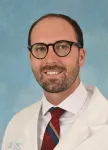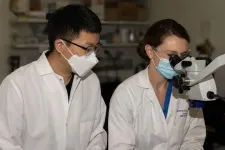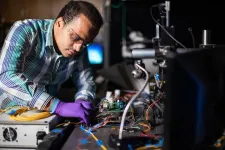(Press-News.org) CHAPEL HILL, North Carolina--Researchers at the UNC Lineberger Comprehensive Cancer Center demonstrated in a clinical trial in Malawi that a five-drug combination chemotherapy provided curative benefit compared to current standard-of care-therapy in people diagnosed with lymphoma, and now they have determined this option is also cost-effective. The economic finding appeared July 22, 2021, in Lancet Global Health.
The clinical trial results, reported May 19, 2021, in Lancet Global Health involved 37 people with diffuse large B-cell lymphoma (DLBCL). The majority of patients were also HIV-positive, which greatly increased their risk of DLBCL; all HIV-positive patients were treated with anti-viral drugs. The trial participants received a standard four-drug chemotherapy combination known as CHOP (cyclophosphamide, doxorubicin, vincristine and prednisone) along with rituximab, an antibody therapy. After two years of follow-up, 55 percent of the patients were still alive, an outcome that is higher than CHOP alone based on earlier studies.
With the trial results in hand, the researchers wanted to know if either CHOP or CHOP plus rituximab were cost-effective treatments in a resource-limited setting. Demographically, Malawi is a sub-Saharan country in Africa with roughly 19 million residents. The healthcare resources available in the 2017-2018 government budget for Malawi were $170 million dollars (about $9 per person); external donors contribute approximately another $350 million annually to health expenditures.
UNC Lineberger's Matthew Painschab, MD, lead author of the economic analysis and co-lead author of the treatment efficacy study, said cost-effectiveness analyses allow comparisons across diverse diseases so that limited resources can be optimally allocated.
"Without such analyses, relatively expensive upfront costs for cancer medicines will often seem prohibitively costly for a relatively small number of patients compared to other available public health interventions," said Painschab, assistant professor in the Division of Hematology at UNC School of Medicine and a member of UNC-Project Malawi. "We demonstrated that an upfront, time-limited expense followed by decades of healthy life may be a prudent investment, relative to other accepted interventions such as daily, lifelong antiretroviral treatment for HIV."
On a per-patient basis, comparing supportive care (no chemotherapy) to chemotherapy with CHOP, chemotherapy prevented more than seven disability-adjusted life years (DALYs) at a cost of $193 per DALY prevented. One DALY is a year of life lived in perfect health and therefore losses represent both years lost from dying early as well as quality life-years lost to disability. Adding rituximab to CHOP prevented about three DALYs at a cost of $1,145 per DALY.
"Our analysis has important implications for saving lives," said Painschab. "Though precise estimates of cancer incidence are lacking, we estimate it would cost about one million dollars annually to treat all cases of DLBCL in Malawi with CHOP, saving an estimated 252 lives. For two million dollars more annually, we could add rituximab, which costs about $500 a dose in Malawi, and the five-drug regimen could save an additional 100 lives."
In addition to the recently published studies, the researchers are conducting some of the first molecular profiling studies for HIV-associated lymphoma in the world. They hope that greater biologic understanding of DLBCL in Malawi may lead to more targeted, safe and effective treatment strategies. They note there is still much work to be done in this area, both in the U.S. and Malawi.
"Proving that treating DLBCL in Malawi can be cost-effective was not necessarily intuitive, as upfront costs of treating cancer patients often seem daunting for countries facing many competing health priorities," noted Stephen Kimani, MD, a fellow in Hematology/Oncology at UNC-Chapel Hill and research fellow at UNC Project Malawi and first author of the study that found the combination therapy was effective. "Investments in high-quality, potentially curative cancer care may be very prudent when short-term costs result in a normal life expectancy thereafter. These sorts of demonstrations will hopefully spur a treatment access movement for cancer that is analogous to what has occurred for HIV."
INFORMATION:
Authors and disclosures
Cost-effectiveness research
In addition to Painschab, the paper's other authors are Stephanie Wheeler, PhD, UNC Lineberger and UNC Gillings School of Global Public Health; Wilberforce Mhango, Bongani Kaimila, MBBS, MSc, Takondwa Zuze, MBBS, Victor Mithi, MBBS, Edwards Kasonkanji, MPH and Noel Mumba, UNC Project Malawi, Lilongwe; Racquel E Kohler, PhD, Rutgers Cancer Institute of New Jersey, New Brunswick; Richard Nyasosela, MBBS, Kamuzu Central Hospital, Lilongwe, Malawi; and Satish Gopal, MD, formerly of the Center for Global Health, National Cancer Institute, Bethesda, MD.
The research was supported by NIH grants K01TW011470, U54CA190152, D43TW009340, UM1CA121947, P30CA233709, R25CA057711 and T32CA11633911.
Efficacy of treatment research
In addition to Kimani and Painschab, the paper's other authors are Bongani Kaimila, MBBS, UNC Project Malawi and University of Malawi College of Medicine; Tamiwe Tomoka, MMed, UNC Project Malawi, University of Malawi College of Medicine and UNC School of Medicine; Edwards Kasonkanji, Takondwa Zuze, MBBS, Maria Chikasema, Asekanadziwa Mtangwanika, Mena Chawinga, Wilberforce Mhango, Simon Nicholas, Fred Chimzimu, Coxcilly Kampani, Robert Krysiak, MS, Ryan Seguin, MPH, UNC Project Malawi, Lilongwe; Maurice Mulenga, MMed, Richard Nyasoselam, MMed, Malawi Ministry of Health; Amy Lilly,MD, UNC School of Medicine; Cara Randall, MD, West Virginia University; Katherine D. Westmoreland, MD, UNC Project-Malawi and UNC Lineberger; Nathan D. Montgomery, MD, Yuri Fedoriw, MD, UNC Project-Malawi and UNC School of Medicine; and Satish Gopal, MD, Center for Global Health, National Cancer Institute.
The research was funded in part by a UNC Lineberger Developmental Research Award and NIH grants D43TW009340, K01TW011470 and UM1CA121947.
CHAPEL HILL, North Carolina--A new study has demonstrated that patients with advanced bladder cancers whose tumors have a mutated FGFR3 gene respond to immunotherapy treatment in a manner that is similar to patients without that mutation, a discovery that runs counter to previous assumptions. This research, led by scientists at the University of North Carolina Lineberger Comprehensive Cancer Center, has important implications for patients who have not been offered immunotherapy because of their genetic profiles.
The findings are published in the British Journal of Cancer.
The National Cancer Institute estimates that 83,730 people in the United States will be diagnosed with bladder cancer in 2021, and the disease will cause 17,200 deaths. While the cancer ...
ROCHESTER, Minn. -- A new study by Fergus Couch, Ph.D., of Mayo Clinic Cancer Center, along with collaborators from the CARRIERS consortium, suggests that most women with breast cancer diagnosed over 65 should be offered hereditary cancer genetic testing. The study was published Thursday, July 22, in the Journal of Clinical Oncology.
Dr. Couch says that women over 65 rarely qualify for hereditary cancer genetic testing based on current testing guidelines because they are thought to exhibit low rates of genetic mutations in breast cancer genes.
"Most studies of breast cancer genes have not looked at older women, those who were diagnosed over the age of 65," says Dr. Couch. He says these studies have mainly tested women with a strong family history of breast ...
- Data show dose-responsive, non-saturated increases in gastrointestinal consumption of Phe in humans by SYNB1618 -
- SYNB1618 Phase 2 study in patients with PKU ongoing with proof-of-concept readout anticipated in 2H 2021 -
- Phase 1 study of SYNB1934, an evolved strain of SYNB1618 in the PKU portfolio, initiated -
CAMBRIDGE, Mass., July 22, 2021 /PRNewswire/ -- Synlogic, Inc. (Nasdaq: SYBX), a clinical stage company bringing the transformative potential of synthetic biology to medicine, announced today the publication of two papers in the journals Nature Metabolism and Communications Biology. The publications detail findings ...
Millennials, often referred to as the "job-hopping generation," represent a group of young workers who once grabbed the national spotlight with their publicized demands for "fun" work perks, such as happy hours. However, researchers at the Novak Leadership Institute at the University of Missouri and Kansas State University discovered today's young workers -- ages 21-34 -- represent a life-stage shift toward placing more value on having respectful communication in the workplace over trendy work perks.
"Millennials have been called the 'entitled generation,' and they kind of give young workers a bad rap because their often-publicized interests ...
Having friends may not only be good for the health of your social life, but also for your actual health--if you're a hyena, that is. Strong social connections and greater maternal care early in life can influence molecular markers related to gene expression in DNA and future stress response, suggests a new University of Colorado Boulder study of spotted hyenas in the wild.
Researchers found that more social connection and maternal care during a hyena's cub and subadult, or "teenage," years corresponded with lower adult stress hormone levels and fewer modifications to DNA, including near genes involved in immune function, inflammation and ...
The body's so-called good cholesterol may be even better than we realize. New research from Washington University School of Medicine in St. Louis suggests that one type of high-density lipoprotein (HDL) has a previously unknown role in protecting the liver from injury. This HDL protects the liver by blocking inflammatory signals produced by common gut bacteria.
The study is published July 23 in the journal Science.
HDL is mostly known for mopping up cholesterol in the body and delivering it to the liver for disposal. But in the new study, the researchers identified a special type of HDL called HDL3 that, when produced by the intestine, blocks gut bacterial signals ...
By analyzing peoples' visitation patterns to essential establishments like pharmacies, religious centers and grocery stores during Hurricane Harvey, researchers at Texas A&M University have developed a framework to assess the recovery of communities after natural disasters in near real time. They said the information gleaned from their analysis would help federal agencies allocate resources equitably among communities ailing from a disaster.
"Neighboring communities can be impacted very differently after a natural catastrophic event," said Dr. Ali Mostafavi, associate professor in the ...
Most people can expect to break close to two bones in their lifetime, but those with osteogenesis imperfecta -- also known as brittle bone disease -- can break hundreds of bones before they even hit puberty. And while healthy bones can break from a hard fall or a bad car wreck, there may not be an apparent reason at all with brittle bone disease.
Classified as a rare disease, osteogenesis imperfecta, or OI, affects 6-7 people out of every 100,000 live births and can range in severity depending on the specific mutation. And while there are currently few treatment options and no cure, ...
DURHAM, N.C. - Scientists at Duke University have developed a suite of four new tests that can be used to detect coal ash contamination in soil with unprecedented sensitivity.
The tests are specifically designed to analyze soil for the presence of fly ash particles so small other tests might miss them.
Fly ash is part of coal combustion residuals (CCRs) that are generated when a power plant burns pulverized coal. The tiny fly ash particles, which are often microscopic in size, contain high concentrations of arsenic, selenium and other toxic elements, many of which have been ...
According to the United Nations' telecommunications agency, 93% of the global population has access to a mobile-broadband network of some kind. With data becoming more readily available to consumers, there is also an appetite for more of it, and at faster speeds.
Ramy Rady, doctoral student in the Department of Electrical and Computer Engineering at Texas A&M University, is working with Dr. Kamran Entesari, his faculty advisor and professor, and Dr. Christi Madsen, professor, to design a chip that can revolutionize the current data rate for processors and technologies such as smartphones, laptops, etc. Dr. Sam Palermo, ...





